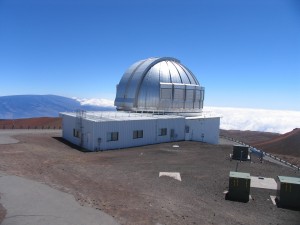Maunakea Scientists Study Potentially Habitable Planets
UKIRT, one of the observatories on Maunakea on Hawai‘i Island, is currently studying a fascinating system of small planets that are orbiting a nearby cool red star called TRAPPIST-1.
Three of these planets are considered to be in the habitable zone, where conditions would allow liquid water to exist on the surface and potentially allow for life to exist.
Learn more about this quest for knowledge at ‘Imiloa Astronomy Center of Hawai‘i’s Maunakea Skies talk on Friday, Nov. 17, 2017, at 7 p.m. with UKIRT Observatory Director Dr. Bob McLaren.
Originally known as the United Kingdom Infrared Telescope, UKIRT is now operated by the University of Hawai‘i’s Institute for Astronomy. With its 3.8-meter primary mirror, UKIRT is the largest telescope in the Northern Hemisphere dedicated solely to infrared astronomy.
TRAPPIST-1 is very nearby; only 40 light years away. It is classified as an M8 dwarf, which means that it has a mass of about 8% that of our Sun and a size only slightly larger than Jupiter.
A total of seven planets have been discovered around TRAPPIST-1 by using the transit technique, in which astronomers carefully measure the small dimming that occurs when one or more of the planets crosses in front of the star.
With its sensitive infrared camera, called the “Wide Field Cam (WFCAM),” UKIRT is able to measure the transit dimming with a photometric accuracy of 500 parts per million and a timing accuracy of 20 seconds.
Dr. McLaren will describe how UKIRT’s observations have played a major role in establishing the amazing multi-planet nature of the TRAPPIST-1 system. He will also explain how these same observations have revealed that all seven planets have masses close to that of Earth.
Dr. McLaren obtained his Ph.D in physics from the University of Toronto, Canada in 1973. He worked at the Canada-France-Hawaii Telescope (CFHT) and served three years as CFHT executive director just prior to joining the University of Hawai‘i. He was associate director at the University of Hawai‘i Institute for Astronomy from 1990 until March 2017. His main work was the implementation of the university’s plan for astronomy development on Maunakea, including the permitting and other local arrangements for the Keck-2, Subaru, Gemini and Submillimeter Array facilities.
Over the past decade, he has utilized much of his time on site testing, planning and permitting for the Thirty Meter Telescope. He has taught introductory astronomy courses at both the University of Hawai‘i and University of Toronto.
Hosted by Planetarium Technician Emily Peavy,‘Imiloa’s monthly Maunakea Skies program includes observational highlights of the current night sky over Hawai‘i, with audiences able to view prominent constellations and stars visible during this time of year.
General admission tickets are $10; $8 for ‘Imiloa members. Pre-purchase tickets at ‘Imiloa’s front desk or by phone at (808) 932-8901.
Maunakea Skies planetarium presentations are held on the third Friday of each month.
The ‘Imiloa Astronomy Center is located at 600 ‘Imiloa Place in Hilo.














